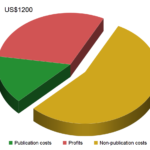Time and time again, academic publishers have managed to create the impression that publishing incurs a lot of costs which justify the outrageous prices they charge, be that US$11M p.a. for an Elsevier Big Deal subscription or an article processing charge (APC) of US$5,200 for a Nature Communications article.
This week, again, an academic publisher, SpringerNature, reaffirmed its readers that they have huge costs that necessitate the price they charge. This time, the publisher repeated their testimony from 2004 that “they have high internal costs” that amount to €10,000-30,000 per published article:
Springer Nature estimates that it costs, on average, €10,000–30,000 to publish an article in one of its Nature-branded journals
However, in their 2004 testimony, where they state figures in a similar range, they explain how they arrive at these numbers:
The £30,000 figure was arrived at simply by dividing the annual income of Nature (£30 million) by the number of research papers published (1,000).
This means that what the publishers are referring to isn’t their costs for publishing at all, it is the price that they charge the public for all of their services.
It is well established that the cost of making an article public with all the bells and whistles that come with an academic article is between US$/€200-500. This is the item one would reasonably call “publication costs”. Because they are so low, this item cannot be the main reason for the price of a typical Nature branded article. SpringerNature performs additional services, some of which are somewhat related to the publication process, other not so much.
For instance, journals such as Nature or Science reject about 92% of all submitted articles. Someone needs to read and reject all of these articles. Such “selectivity” is explicitly mentioned as a reason for the high prices.
It is important to keep in mind that this expensive selectivity fails to accomplish any increase in quality and is thus completely ineffective. The entire practice is thus very reminiscent of how potatoes were introduced in France. Nevertheless, the salaries of the employees who reject all these manuscripts are a cost item, effective or not. As it only concerns all the articles not published, it sounds rather absurd to lump this item in with “publication costs”, even though it is sort of related (Non-publication costs? Rejection costs?).
Another cost item is the paywall used to prevent non-subscribers from accessing the articles. Such paywalls can be very expensive, as, for instance, the New York Times is reported to have spent anywhere between US$25-55M for their paywall. Running a paywall to prevent unauthorized users from reading the articles is another cost item. This one, I would argue, is even less related to publishing.
Finally, there are cost items that are completely and rather uncontroversially unrelated to publishing, such as salaries for management, executives or government relations, as well as other costs such as journalism and news services, the latter explicitly mentioned in the recent article.
All of these cost items together make up the ~€10,000-30,000 that are currently being paid for an article in the SpringerNature stable and there are no reasons to doubt this price tag. Importantly, peer-review is not a cost item as the reviewers are paid via their academic salaries and not by the publisher. Authors are also not paid by the publisher, so this is also not a cost item. The person organizing the peer-review is usually one of the persons rejecting all those other manuscripts, so 92% of their salary are already covered by the rejection costs.
If the scholarly community accepts this price as reasonable, it needs to be prepared to explain to the tax-payer, why it is justified to use public funds to pay a private company such as SpringerNature less than ~€500 to publish a scholarly article in one of their journals and then an additional ~€29,500 for cost items such as ineffectively rejecting articles, making sure the ‘published’ articles remain difficult to access for most ordinary tax payers and the salaries of the company’s executives and lobbyists.














But publishing is a competitive and risky business with extremely unstable profits, you must also consider the cost of capital from the poor shareholders!
🙂
Comments are closed.